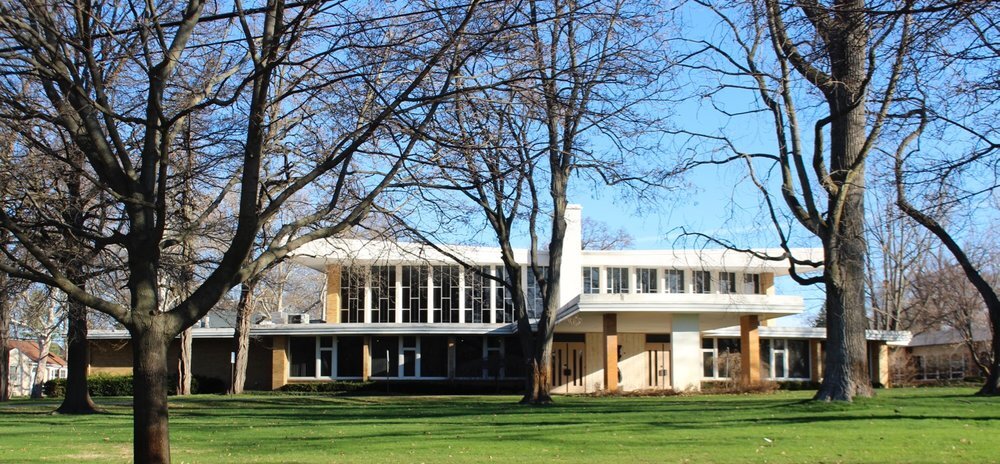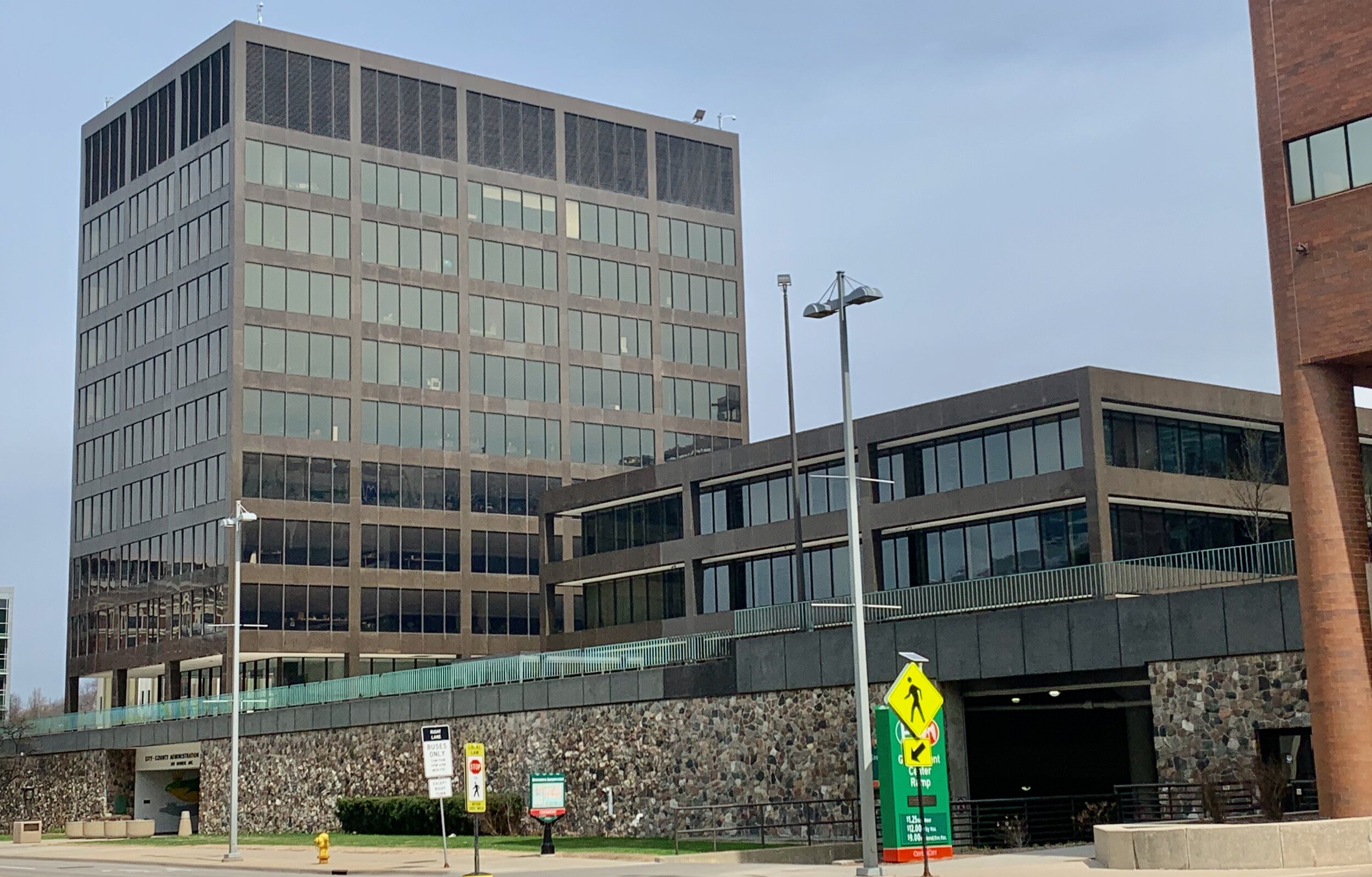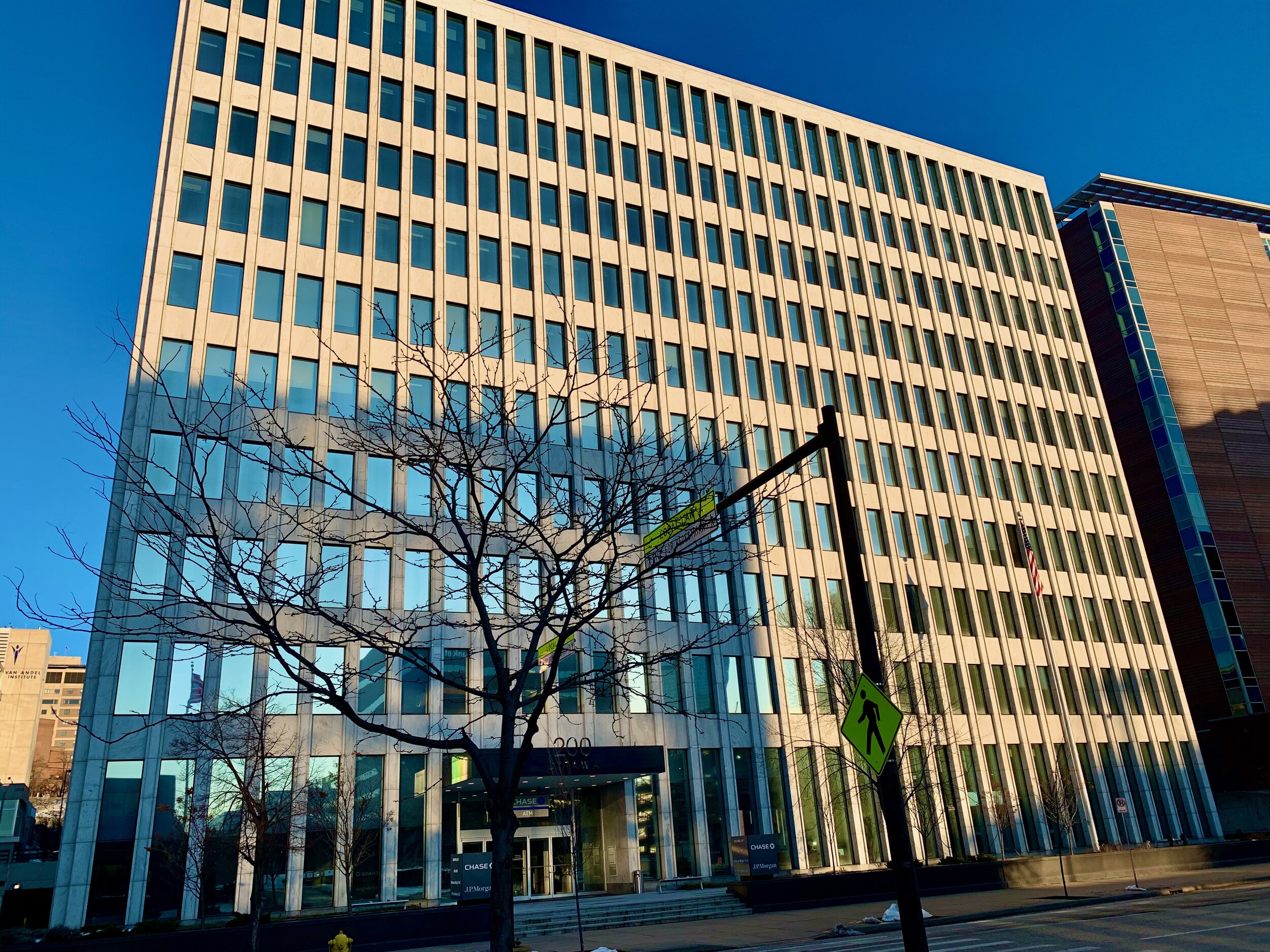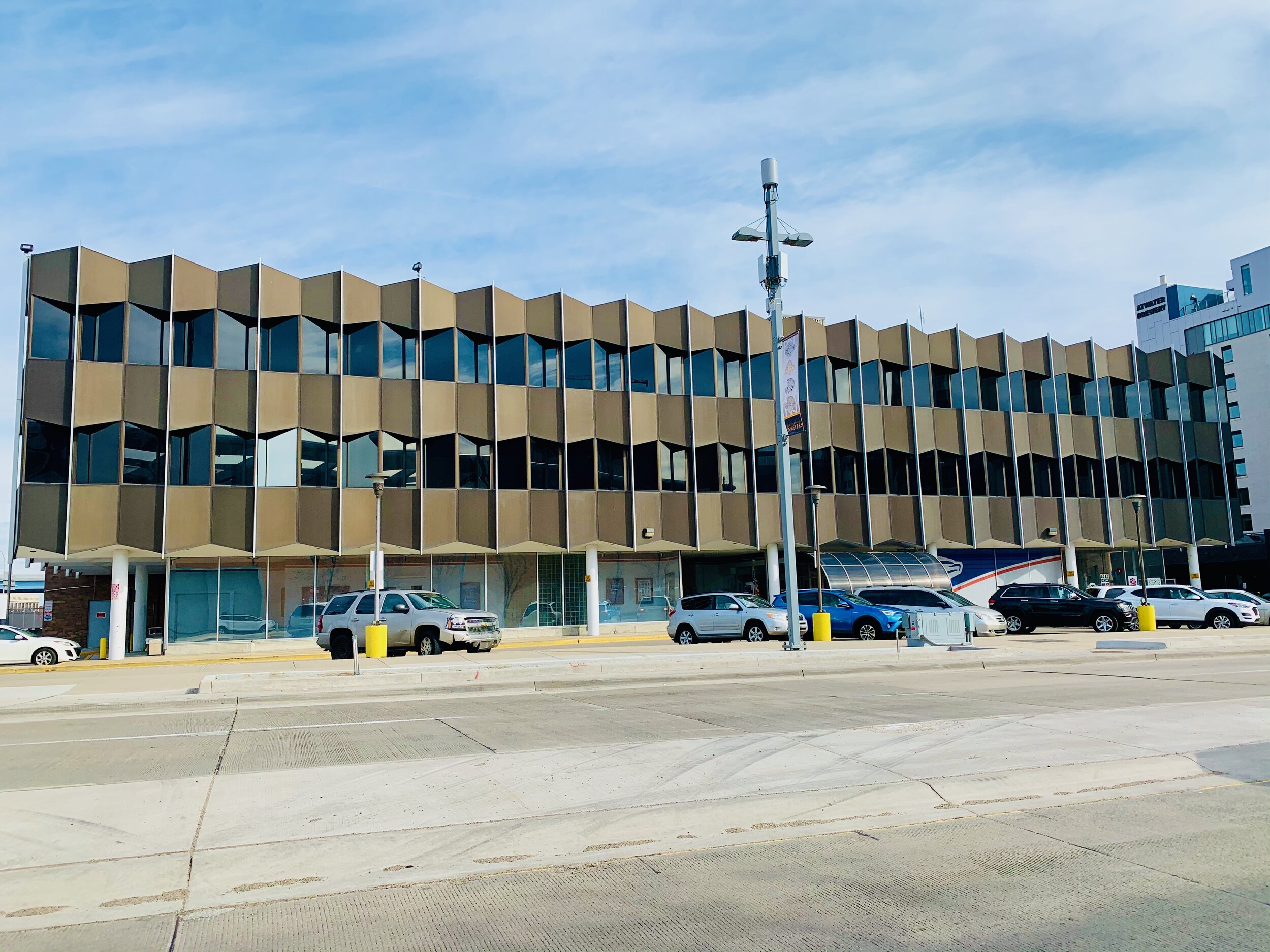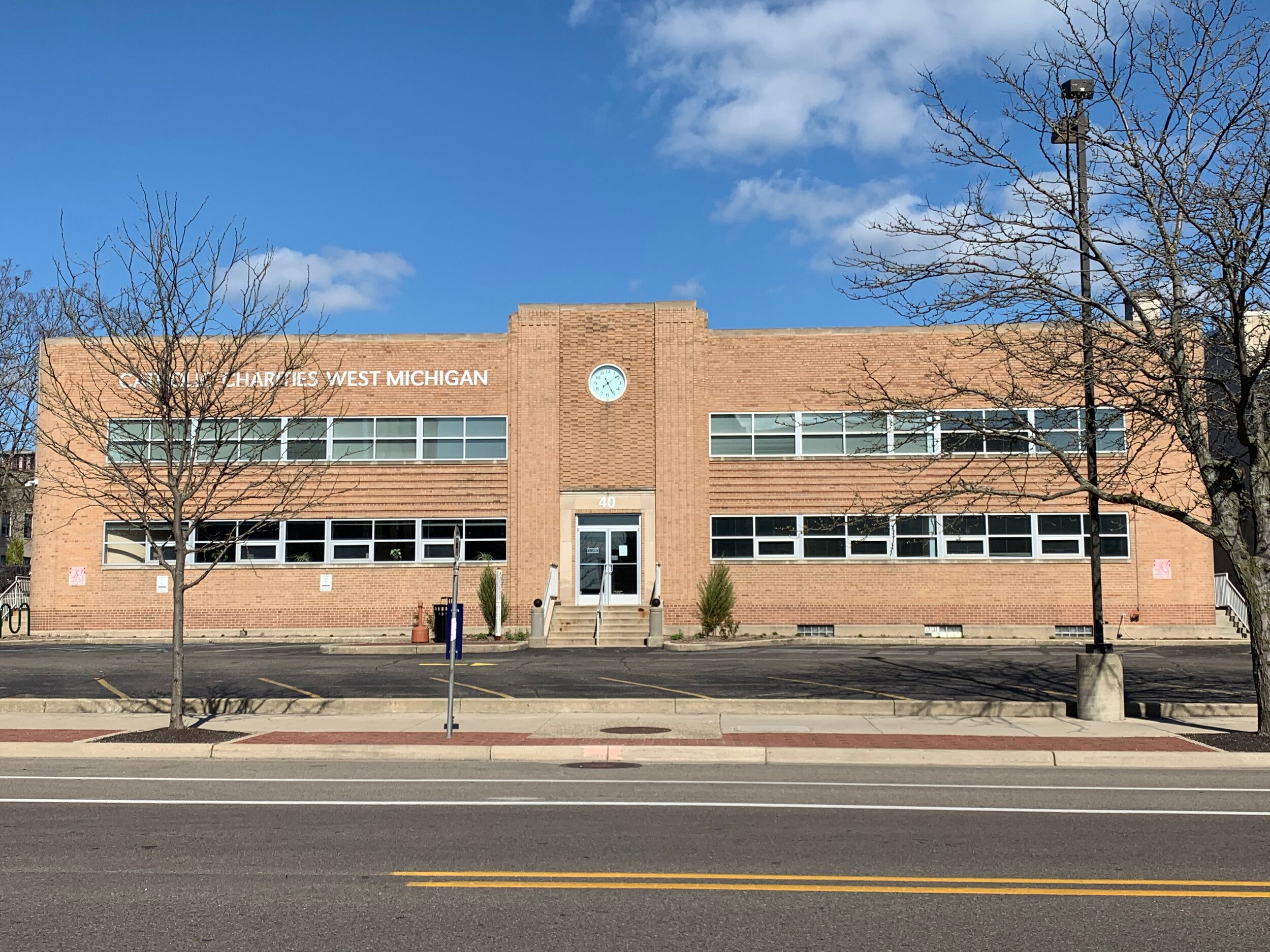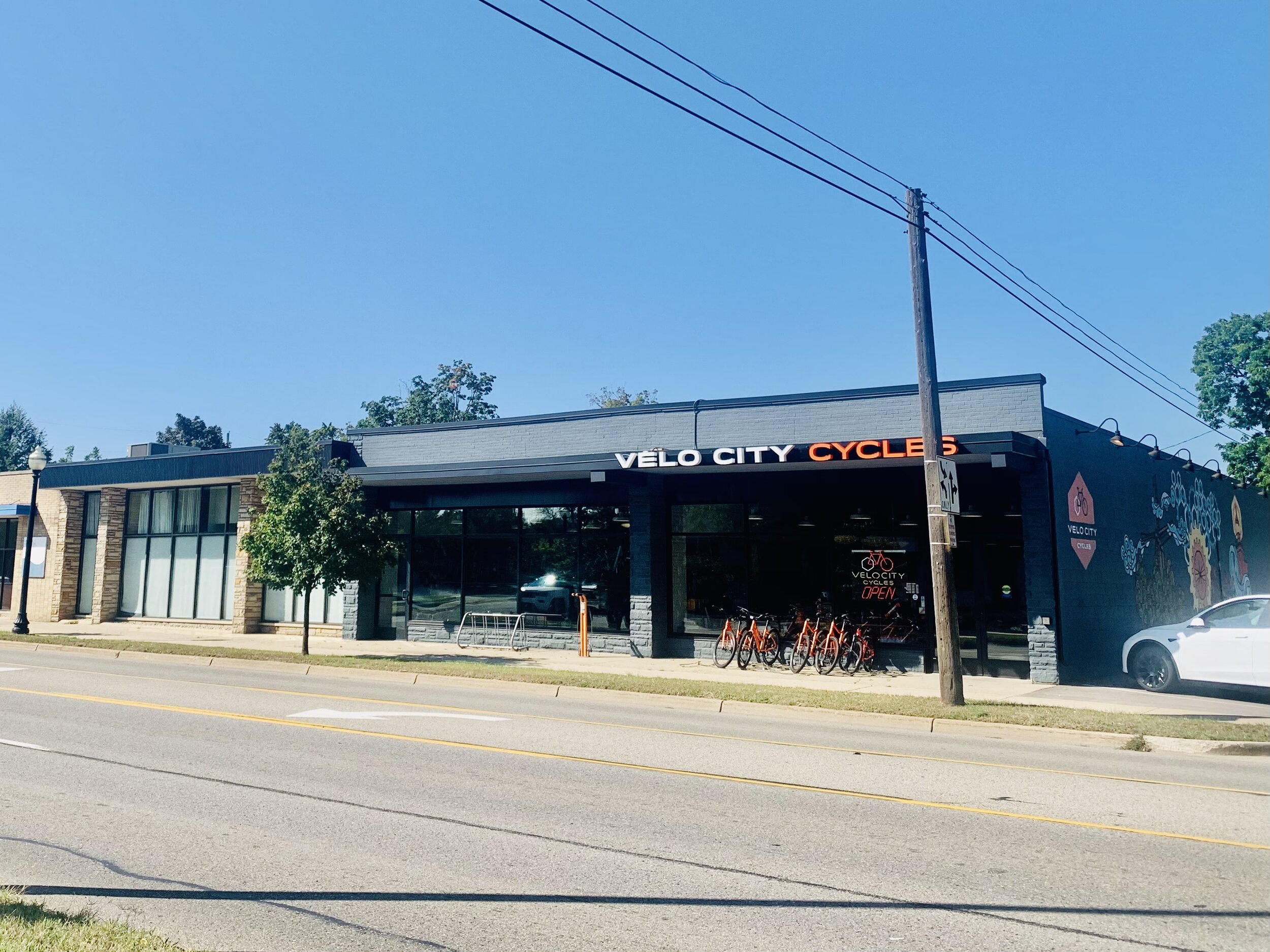
MID-CENTURY MODERN TRAVEL & LEISURE
INTRODUCTION: From the 1940s through the 1970s) architects and builders changed the look of cities like Grand Rapids and Lakeshore resort towns with modern architecture that merged new technology with innovative design. Many of the sites on this virtual tour are simple and inexpensive modern structures transformed into trendy shops, fine dining, ice cream parlors, libraries and bookstores. Some were more complicated, revolutionary, and important to the historic building stock. Some are so beautiful they just need to be viewed and appreciated.
MID-CENTURY MODERN TRAVEL & LEISURE IN WEST MICHIGAN —A VIRTUAL TOUR
1. Grand Rapids Buildings/Sites
2 - Wealthy Street Repurposed Service Stations
3. ROAD TRIP to Lakeshore MCM sites.
CREDITS: This Virtual Tour is an expanded version of the West Michigan portion of the Docomomo US/MI Chapter Virtual Tour developed by Pam VanderPloeg in collaboration with the Docomomo U.S./MI Chapter. Project Chair, Katherine White, Henry Ford Curator of Design DOCOMOMO-MI board member.
1 - Grand Rapids Buildings & Sites
During the 1920s in Grand Rapids large areas of vacant lands and a number of golf courses were platted with the intention of developing new neighborhoods. The Depression and World War II put a near end to the building industry. It wasn’t until the end of World War II that new optimism created incredible growth and the wonderful mid-century buildings you see below. The city annexed large areas of the surrounding townships and the city expanded. Urban renewal resulted in the demolition of old buildings in the downtown area (some beloved like the old city hall) and the construction of new modern office towers.
During 1940s to 1970s era building boom, nationally known architects like Eric Mendelsohn, Gunner Birkerts, the firm Skidmore, Ownings and Merrill, and artist Alexander Calder designed modern structures that now sit side-by-side with the modern architecture designed by Grand Rapids own mid-century architects like Daverman Associates, David Post, E. John Knapp, Marvin DeWinter, Paul Bower and Robert Wold, Harris VerSchure, and so many others. A selection of these are included below as part of this virtual MCM Travel & Leisure tour.
East of Downtown on Fulton Street View: Temple Emanuel (1715 E. Fulton) a midcentury masterpiece designed by architect Eric Mendelsohn 1952-1955.
Temple Emanuel sits at a slight angle to the street. The full-length clerestory windows on the second level are separated by a vertical element creating the illusion of wings - one reference being to a bird in flight. The windows flood the interior with light. The yellow brick and white trim facade is approached via a deep covered walkway. An original sculpture by Carl Albert separates the two sets of glazed double doors under the deep projecting entry roof. The interior features a recently restored 1000 square foot mural created by painter Lucienne Bloch Dimitroff, protégé of Diego Rivera, decorated with important symbols of the faith. Beautiful burnished wood walls are movable.
SNACK: Stop for something sweet at the Cakabakery, a custom dessert bakery (919 E Fulton) 1958. The modern two-story office building with glass curtain wall and floating stairway was built by contractor John E. Vandenberg.
PLAY AND SHOP: Enjoy the current exhibits, have a painting or print framed or shop at the popular gift shop in Lafontsee Gallery (833 Lake Dr SE) 1963. The two-story building was known by city residents for years as the Lake Drive Medical Building. Contractor was Russell . F. Donker Associates.
Join a hot Yoga class in the multi-level MCM Boland Building (1331 Lake Dr. SE) 1957 constructed by the Boland Building Company as an office building. It is located in the heart of the historic Eastown neighborhood, home to many popular restaurants and shops.
PLAY: Shop for custom-designed jewelry at the Metal Arts Studio (978 Cherry St SE )1957, a former Old Kent Bank Branch building. The restoration undid a renovation that imposed a windowless facade over the original design. In the last 20 years, Cherry Street has become a hub of bars, eateries, and shopping.
SHOP: DTLR/VIlla (4 E. Fulton) downtown in the 1949 restored Moderne building. The building designed by Architect Willifred McLaughlin was designed as the Davenport Institute, the founding institution that is now Davenport University. It was later known as the home of Junior Achievement and after being vacant for many years and the location of the ArtPrize/SiteLab exhibit, it was restored by Tower Pinkster earned Platinum level LEED certification. The upper floor houses the offices of Tower Pinkster
DINE: Picnic under the Calder, La Grande Vitesse sculpture on Vandenberg Plaza completed in 1969 and designed by noted sculptor Alexander Calder on Vandenberg Plaza. Today the Calder is the city symbol and the plaza is the site of many festivals including the Festival of the Arts and gatherings
VIEW: Adjacent to the Calder are the SOM designed Grand Rapids City Hall (200 Monroe NW) 1969 at ten stories and the Kent County Administration Building (300 Monroe NW) 1969 at three stories. These buildings were completed as part of the city’s urban renewal project.
VIEW: The Union Bank Building was designed by Carson Lundin Shaw with associate architect David Post. The street is Ottawa Avenue NW and at the corner of Ottawa and Lyon once stood the beloved Grand Rapids City Hall designed by Elijah Myers. Nearby was the old Kent County Courthouse designed by Sydney J. Osgood, other old buildings considered by then civic and business leaders to be a part of a perceived problem of urban blight. Urban renewal involved closing and reworking designated downtown streets, demolishing old buildings, and creating the Vandenberg Plaza. Today sleek modern office towers like the Union Bank Building look out on the Calder stabile and Vandenberg Plaza.
SHOP: Buy stamps at the ultra-modernist U.S. Post Office 1962 designed by J. &. G. Daverman. It was in this new post office, a product of Grand Rapids urban renewal that the innovative new zip code sorting program was unveiled. Mail a postcard there about your Travel and Leisure MCM tour.
STAY: The historic 1923 Morton House reopened in 2021 as a dog-friendly hotel and features “Bauhaus-inspired” interiors that were designed by Gensler. The original building was designed by famed Chicago architects Holabird & Roche to meet the Furniture Industry’s continuous need for upscale hotel rooms. The last restoration and modernization was in 2013 by Rockford Development.
STAY: Although the building is much older than the mid-century, the AC Hotel includes a modern interior with a library designed with custom-designed Eames lounge chairs. The building was once part of the 19th-century Grand Rapids Refrigerator Company complex. The three buildings of the complex were recently separated and the original brick facade was revealed and repaired. Contractor was Rockford Construction.
EAT: The Commons (547 Cherry St SE Suite C) restaurant. Established in 2018 in the lower level of the Oakwood Apartments. Known as the Oakwood Manor when it was constructed in 1923 these were considered elegant apartments and were often home to retirees and former furniture industry executives. The Commons is self-described as a “throwback twist on American classic comfort food’ and has a 1970s ambiance with MCM furniture and accessories.
PLAY/WORKOUT: Work out at the 8th Day Gym (125 Market). This early 1960s MCM building with its distinctive folded plate roof was built for Ronda Tire, a facility designed to retread and sell tires. The architect was E. John Knapp AIA of O’Bryon & Knapp who later became an expert in veterinarian hospital design in Wisconsin and died in Jefferson City, Kansas at the age of 100.
VIEW: The Fanatorium Building (40 Jefferson SE) 1949. Built for bowling and now the Catholic Charities Offices. Here Marian Ladewig, nationally known as the “Queen of Bowling” trained and played nearly everyday during her career. Renovated in 2000 by Cornerstone Architects.
PLAY: Across the river is Clique Lanes (533 Stocking Ave NE) 1953 a 16-lane bi-level lane bowling center, one of only a handful of double-decker bowling lanes in Michigan.
DINE: And for an old-fashioned burger joint, stop at Fat Boy Burgers (2450 Plainfield Ave NE) 1952. This building is representative of all of those 1950s burger joints and franchises although it opened originally as the Tastee Freez in 1952. Soon it became the neighborhood hamburger joint known today as the Fat Boy Burgers. There was a second location on Michigan Street in the 1960s but that is now gone. The Fat Boy closed in 2009 and that is when Matt and Jill Urbane bought and restored the building, repainting and adding new booths. They refurbished the original metal and red neon sign to draw diners today to this mid-century and family-friendly icon.
DINE: Lucy’s Cafe (1747 Plainfield Ave NE) 1958 originally constructed in three phases (1958-1963) as a Daane’s Food Market. It became D’Amicos Food Market in 1978 when Rose D’Amico purchased the building after winning the lottery according to an article in the Grand Rapids Press. This Plainfield institution closed finally in 2011 and this building in the Grand Rapids Creston Neighborhood stood vacant. In 2015 Larry Zeiser and Brian Giampapa invested over a $1 Million in the renovation that converted the market into a popular breakfast and lunch restaurant in the one-story building and a bistro that later became an event venue in the adjacent two-story building.
STAY/SHOP: Woodland Airstream (5190 Plainfield Ave.) About 1966. It began as Woodland Trailer Center and was one of the first buildings in the nation with an indoor showroom and a service facility specifically designed to sell and service travel trailers and campers. They sold the airstream trailers or caravans that became highly popular after World War II when airplane technology and World War II factory facilities were used to produce the distinctive rounded polished aluminum style. Woodland AIrstream’s glass fronted sales/service area was designed in the early 1960s as the dealer’s modern main showroom by award-winning Grand Rapids church architect Edgar Firant. Today it is the Woodland Airstream and there you can buy a new or vintage airstream at one of the oldest continuously operated airstream dealerships in the country.
PLAY: Northfield Lanes (2222 Plainfield Ave NE) opened about 1947. The bowling center has 16 lanes, billiards tables and a sports bar. Marion Ladewig, who was named Female Bowler of the Year nine times between 1940 and 1963, was part-owner for many years.
2 - Wealthy Street Mid-Century Repurposed Service Stations
In the last twenty years, abandoned service stations on historic Wealthy Street SE have been renovated and repurposed. Wealthy Street is a busy Grand Rapids east-west corridor full of historic homes, dotted with commercial buildings, and home to a large number of trendy restaurants—even a coffee trailer. The old service stations were traditionally built on busy corners to attract motorist’s attention. These buildings are right-sized for restaurants and, being located in close proximity to one another, they create a real draw for pedestrians and motorists. The buildings date from the 1920s through the 1950s. Architectural styles range from Spanish/Mediterranean to moderne and mid-century modern. Reinvestment in the Wealthy Street neighborhood has created an eclectic mix of renovated buildings with great shopping, dining, and coffee shops. Not all of the buildings arel MCM.
Road trip! Lakeshore MCM Sites
Some fun MCM destinations found along the lakeshore. Although many Lake Michigan shoreline resort venues are open primarily in the summer months, West MIchigan sugar sand beaches are spectacular year-round and are a must-do day trip being just a mere 30-45 minute drive from Michigan cities like Grand Rapids and Kalamazoo. Note: the park concessions and pavilion buildings are only open in the summer months.
History: When the first state parks were established in the 1920s, yearly attendance was measured in 1922 at about 244,000 visi- tors. By 1955, state parks welcomed roughly 17.8 million visitors — a 70-fold increase. During the same time period, Michigan’s population rose dramatically from 3.9 million to 7.3 million, an increase of over 180 percent. — Michigan DNR. (From the DNR website).
Saugatuck’s Lake Michigan Oval Beach was rated one of the nation’s top 25 beaches. Both Saugatuck and neighboring Douglas have been extremely popular with tourists throughout the 1900s and there are modern buildings to be found in downtown Saugatuck and neighboring Douglas. Examples include the converted Harriss Pie Company Factory, now the modern Saugatuck Center for the Arts. Also many mid-century buildings survive along the area’s historic Blue-Star Highway. Blue Star Highways were designated in this way in 1945 in locations around the nation following World War II to honor the U.S. Armed Forces, a project sponsored by The National Council of State Garden Clubs. The symbolism of the blue star is that it was used on service flags to denote a service member fighting in the war. The MCM buildings along this historic highway include restaurants, ice-cream shops, motels, and shops.
DINE: AT THIS ROADSIDE ATTRACTION: The Douglas Root Beer Barrel (455 Center St.) 1952. The Douglas Root Beer Barrel (455 W. Center St., Douglas, MI) 1952 was built by Joe Decker and Harold Kelly in Flint, Michigan. They brought it to the Oval Beach near Saugatuck and it was supposedly used for selling hot dogs and root beer. The Barrel has had several owners and today it has reopened selling Wisconsin Sprechers Rootbeer at its roadside location.
STAY: The Lake Shore Resort (2885 Lake Shore Drive) was featured in the 2020 Midwest Living magazine article “ Midwest Lakeshore Resorts That Have Been Totally Transformed.” When Joseph and Anna Milauckas of Chicago built the low-profile motor-inn retreat in 1952 the first motel rooms were chicken coops, according to their grandson Andrew. The couple used billboards on area roads to draw visitors with the saving “Quiet on Lake! Color TV! Heated Pool!” and the rest is history.
The Lake Shore Resort has its own private Lake Michigan Beach and stunning views from the resort’s grounds.
PLAY: At the Saugatuck Center for the Arts (400 Culver) 1950s. The SCA converted the abandoned Lloyd J. Harriss Pie Company factory building into a stunning community-based art center with both indoor and outdoor exhibit and event spaces.
DINE: In downtown Saugatuck at Coral Gables (220 Water Street) on 2.5 blocks of waterfront. Built originally in 1906 by the Leindecker family, Tom Johnson purchased the Old Crow Bar and Hotel Saugatuck from Dale Crow in 1958. He built the MCM addition and renamed the complex Coral Gables, Hotel Saugatuck. They kept the nightclub’s name “Old Crow” and in the 1960s young people jammed into the Old Crow to dance. One of the favorite band’s was “Me and Dem Guys” and their rock and roll hit “Black Cloud Hanging Over My Head” performed by one of southwest Michigan’s most popular bands “Me and Dem Guys” who are now in the Michigan Rock & Rock Hall of Fame. Listen here: Black Cloud Hanging Over My Head. Listen here: Black Cloud.
DINE: In downtown Saugatuck at Coral Gables (220 Water Street) on 2.5 blocks of waterfront. Built originally in 1906 by the Leindecker family, Tom Johnson purchased the Old Crow Bar and Hotel Saugatuck from Dale Crow in 1958. He built this MCM addition and renamed the complex Coral Gables, Hotel Saugatuck.
SHOP: At the Saugatuck Antique Pavilion (2948 Blue Star Highway, Douglas) 1950s in the former 1950s Hanson Manufacturing Company factory. From 1976 to 2013 it was home to Haworth Furniture manufacturing. Take your time looking around, you may find some fun mid-century retro design objects and furniture as well as antiques from other eras.
ENJOY CRAFT BEER: Outdoors or inside at Saugatuck Brewing (2948 Blue Star Highway, Douglas) opened in 2005 on the other side of the converted 1950s Hanson/then Haworth factory complex.
DINE: At the Blue Star Cafe and Ice Cream Shop (141 Blue Star Highway, Saugatuck/Douglas) with its distinctive rounded moderne roof, outdoor patio and retro interior.
Another MCM ice cream venue is the Dairy Dayz (6471 Blue Star Highway).
STAY: At the MCM Starlite Motel (3353 Blue Star Highway Saugatuck/Douglas) built in the 1960s/1980 and open May through October.
Eat at the Pennyroyal At Pennyroyal (3319 Blue Star Highway)1960. The restaurant opened in a converted MCM building and is named for the historic mint plant once used by the ancient Greeks and as a staple in the early Native American healing tradition.
HOLLAND—Drive north about 12 miles to Holland. Holland began as a Dutch settlement founded in 1847 by Albertus van Raalte. From the beginning the big lake was important to the settlement’s prosperity and growth. Today’s Ottawa Beach Road follows the channel between Lake Macatawa and Lake Michigan but the deep water channel wasn’t there in the 1840s. Van Raalte and the settlers, lacking another means to dredge the channel for ship traffic, had to dig it out themselves. In the mid-century Ottawa Beach Road like today is the road to the popular Holland State Park Beach —
PLAY: Take a drive to the busy Holland State Park Beach. (2215 Ottawa Beach Road). Public Works Administration funds were used to construct the modern pavilion-bathhouse, which was completed in 1940. The Holland State Park pavilion is an MCM favorite with tourists and local residents.
While you are there, walk over to the channel to view the famous lighthouse known affectionately as Big Red. It was built in 1907 and the lighthouse is run by a nonprofit organization. It is currently closed to visitors. Read the detailed information concerning
While you are there, walk over to the channel to view the famous lighthouse known affectionately as Big Red. It was built in 1907 and the lighthouse is run by a nonprofit organization. It is currently closed to visitors. Read the detailed information concerning accessibility, parking, etc. as the area is surrounded by private property. https://bigredlighthouse.com.
DINE: Along the Ottawa Beach Road, you can stop for a meal or drinks at the Ottawa Beach Inn (2155 Ottawa Beach Road) 1972 near the Holland State Park.
LAKE RANCH RESORT (2226 Ottawa Beach Road) 1952. Advertisement from the day.
The elevated pool at the Lake Ranch Resort still has the 1950s windows that allow underwater viewing.
LAKE RANCH RESORT (2226 Ottawa Beach Road) 1952. Early Postcard.
STAY: Open through mid-October, the Lake Ranch Resort (2226 Ottawa Beach Road) overlooking Lake Macatawa was established in 1952. True to its original motel design, some units as shown have a great view of the lake.
SHOP: At Velo City Cycles (326 S. River) 1954 is a bicycle shop in a remodeled Mid-Century Building that was built as the clothing store “DOTS,” for Mrs. Arend Bosman. The contractor was Harvin Zoerhof and the cost was $10,000. The store advertised “fragile fabrics, mysterious colors, and billowing lines.” They also advertised bridal notions, jewelry, and lace-covered bibles.
The original Herrick District Library was designed by Detroit architect Carl S. Pirscher. The contractor was Kreighoff-Lenawee Construction Company of Adrian, Michigan. The cost ws $300,000, funded by philanthropist Ray Herrick of Tecumseh Products. Grand Rapids artist Gerald Mast painted a mural in the new library. In 1999 a major expansion designed by FGM ( Frye, Fillan & Molinaro Architects Ltd.) of Chicago transformed the library but preserved the original exterior fronting River Street.
In Downtown Holland:
SHOP: At Readers World (194 S River Street) at the intersection of 8th and River) 1967. Here magazine racks stretch almost the length of the store. The older building was once a pharmacy.
SHOP: At the Herman Miller Office Outlet/Company Store (455 Washington), Zeeland. Here you can pick up the iconic furniture and accessories designed by famed Herman Miller designers like Ray and Charles Eames during the Mid-century including Eames lounge chairs to Nguchi coffee table.
GRAND HAVEN AND MUSKEGON: While modern architecture was going up all around them West Michigan teens channeled California, built homemade boards to surf Lake Michigan, collected vinyl records, and grew up in the post-war ranch homes their parents bought in new suburban neighborhoods. In this section we start at the Grand Haven State Park beach.
PLAY: Grand Haven State Park (1001 Harbor Drive) opened in 1920. In 1938 this concrete pavilion/bathhouse building was constructed in the Moderne style was completed using Public Works Administration funds. Although Lake Michigan in October will almost certainly be too cold for swimming, visitors enjoy a walk on the beach, soak up some fall sunshine and play in the sand and shop on Main Street.
PLAY: Another fine option for a lovely fall walk is Duncan Woods (1115 Sheldon Boulevard) 1913. Located off Sheldon Road, Duncan Woods is a nature preserve of beech and hemlock trees and can be enjoyed year-round. It includes a walking area through the forested back dune. From 1940-1973 motorists were able to access a paved road to drive all the way through the preserve. The property downated by Martha Huntington Duncan on her death in 1913. She was the wife of city pioneer Robert W. Duncan who came to Grand Haven in 1851. The beautiful wooded land was adjacent to their home on Lake Drive. It was given to the city for the enjoyment of the public with a trust for its maintenance.
United Methodist Church of the Dunes (717 Sheldon Boulevard) 1960. by Alden B. Dow. The wooded site frees the low-profile church. According to the Aldent B. Dow Studio blog features a. sandy brick exterior, a pitched roof that increases in height from front to back, and a roofline that forms a deep peak over recessed entry doors. For more information link here: United Methodist Church of the Dunes
View: Chevrolet sign (1701 S. Beacon Boulevard) 1960s. This visible industry symbol features the iconic Chevrolet “bowtie” brand developed in 1913 by company co-founder William Durant. In 2019 after being granted landmark status by the city, the historic sign was taken down, checked for structural integrity, refurbished, and fitted with new neon tubes by Postema Signs & Graphics.
DINE: Stan’s Tacos (21 Beacon Boulevard) 1968. The repurposed modern building with it’s stunning roof was formerly the Citizens Bank. It opened recently as Stan’s Tacos. Local artist and Mural by Design owner Sotir Davidhi created a large wall mural for the interior space featuring an aerial view of local Grand Haven landmarks. Although it is currently closed due to staffing shortages, it expects to reopen soon. The owner is Meritage and the restaurant has several locations in metropolitan Grand Rapids.
DINE: You can’t miss the sign on Beacon for Rays Drive-In (20 N. Beacon Boulevard) 1960. Stop for a quick meal in this old-style burger joint. Ray Harz opened Ray's Drive-In offering “beefburgers”, fries, milkshakes, shrimp and fish. It continues to be a popular fast-food location.
PLAY: Getty Drive-In (920 E. Summit) 1948 is still open in 2021. The theater started as a single-screen and was called the NK Outdoor Theater. Grand Rapids theater mogul Jack Loeks Theatres purchased the drive-in and renamed it the Getty Drive-In in 1960. Three more screens were added in 1979 and then it ws the Midwest’s largest. In 1991 an FM radio frequency was offered so that viewers could listen to the movie’s sound via the radio. By the late 1990s it was one of the few remaining operational drive-in theaters. In 2013 the theater converted to digital projection. These facts were found in 7/13/2015 MLive Muskegon article by Michelle D. Anderson.
VIEW: The World War II submarine “The Silversides,” a Gato (Drum) class submarine launched in California in 1941, is docked nearby the Pere Marquette Beach at the U.S.S. Silversides Submarine Museum (1346 Bluff, Muskegon) 1987. The USS Silversides helped the United States Navy sink 23 ships in the Pacific Theater of World War II. It is possible to schedule an overnight “encampment” on the Silversides. Check Museum for details SILVERSIDES. This site is an interesting place to visit if you make a trip to Musekgon but also because architects, builders, engineers were all called up to serve in World War II and the role of these skilled professionals ranged from building extraordinary instruments of war such as submarines, airplanes, and armoured vehicles, developing field housing, designing armaments and vehicles. Following the war’s end the innovative use of new materials and technologies became the norm in mid-century modern building design.
